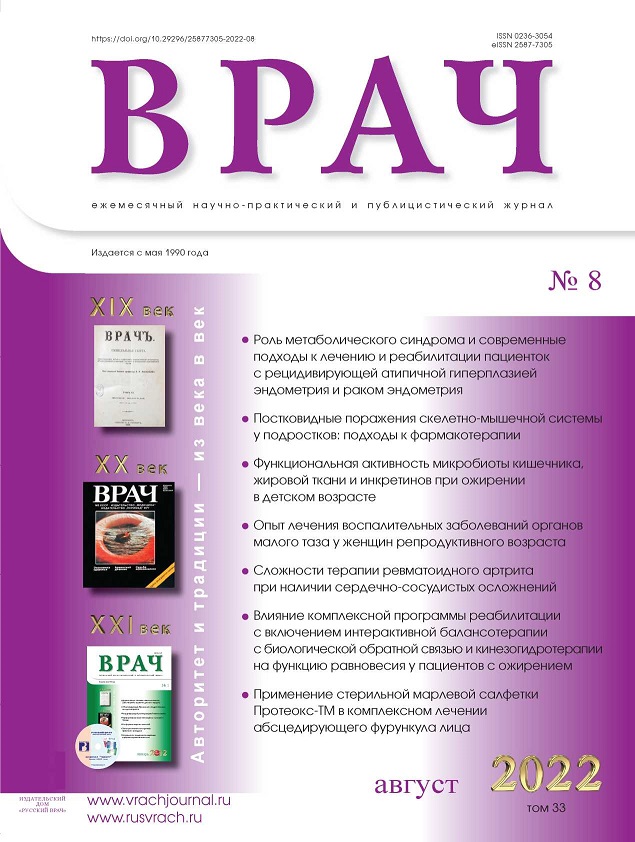The effectiveness of a comprehensive rehabilitation program including interactive balance therapy with biofeedback and kinesihydrotherapy in on the balance function in patients with obesity
- Authors: Vasileva V.A.1, Marchenkova L.A.1, Eryomushkin M.A.1, Kollshenkov V.A.1
-
Affiliations:
- National Medical Research Center of Rehabilitation and Balneology
- Issue: Vol 33, No 8 (2022)
- Pages: 71-74
- Section: From Practice
- URL: https://journals.eco-vector.com/0236-3054/article/view/114675
- DOI: https://doi.org/10.29296/25877305-2022-08-15
- ID: 114675
Cite item
Abstract
Objectives: the study of the influence of a new complex method of physical therapy with the inclusion of balance therapy with biofeedback and kinesihydrotherapy on the human balance function. Material and methods: the study included men and women aged 40 to 65 years with a body mass index >30 kg/m2. Research methods included anthropometry, stabilometry. The patients were further divided into two groups by simple randomization. Patients of both groups underwent a two-week course of medical rehabilitation. Patients of the main group received 4 methods of physical therapy: balance therapy, group classes in kinesihydrotherapy, group classes in a special complex of therapeutic exercises in the hall, aerobic exercises on a stationary bike or treadmill. The patients of the comparison group were treated only with the use of aerobic exercises and therapeutic exercises in the hall according to the same methodology and with the same number of procedures as in the main group. Dynamic observation was carried out at the beginning and after 14 days. Results: according to the data, we obtained an improvement in the balance function on the 14th day of the study in terms of spread along the front(p=0.028) and the spread along the sagittal (p=0.043). Significantly improved indicators in the main group in terms of the average speed of movement of the center of pressure (p=0.018) and the speed of movement of the statokinesiogram (p=0.028), indicators of the area of the ellipse (p=0.018). Conclusions: the new comprehensive program, including aerobic and strength physical training, kinesihydrotherapy and balance therapy, showed a more significant effect on the balance function after completion of the rehabilitation, rather than the standard rehabilitation method.
Keywords
Full Text
About the authors
V. A. Vasileva
National Medical Research Center of Rehabilitation and Balneology
Email: MarchenkovaLA@nmicrk.ru
L. A. Marchenkova
National Medical Research Center of Rehabilitation and Balneology
Email: marchenkovala@nmicrk.ru
доктор медицинских наук
M. A. Eryomushkin
National Medical Research Center of Rehabilitation and Balneology
Email: MarchenkovaLA@nmicrk.ru
доктор медицинских наук, профессор
V. A. Kollshenkov
National Medical Research Center of Rehabilitation and Balneology
Author for correspondence.
Email: MarchenkovaLA@nmicrk.ru
References
- Tomlinson D.J., Erskine R.M., Morse C.I. et al. The impact of obesity on skeletal muscle strength and structure through adolescence to old age. Biogerontology. 2016; 17 (3): 467-83. doi: 10.1007/s10522-015-9626-4
- Алексеева Н.С. Влияние компонентов метаболического синдрома на качество жизни пациентов. Acta Biomedica Scientifica. 2014; 6: 9-13.
- Alley D.E. et al. Grip strength cutpoints for the identification of clinically relevant weakness. J. Gerontol A Biol Sci Med Sci. 2014; 69: 559-66. doi: 10.1093/gerona/glu011
- Vincent H.K., Seay A.N., Vincent K.R. et al. Effects of Obesity on Rehabilitation Outcomes After Orthopedic Trauma. Am J. Phys Med Rehabil. 2012; 91 (12): 1051-9. doi: 10.1097/PHM.0b013e31825f1b19
- Zoico E., Di Francesco V., Guralnik J.M. et al. Physical disability and muscular strength in relation to obesity and different body composition indexes in a sample of healthy elderly women. Int J. Obes Relat Metab Disord. 2004; 28 (2): 234-41. doi: 10.1038/sj.ijo.0802552
- Di Baise J.K., Zhang H., Crowell M.D. et al. Gut microbiota and its possible relationship with obesity. Mayo Clin Proc. 2008; 83 (4): 460-9. doi: 10.4065/83.4.460
- LaRoche D.P., Kralian R.J., Millett E.D. Fat mass limits lower-extremity relative strength and maximal walking performance in older women. J. Electromyogr Kinesiol. 2011; 21 (5): 754-61. doi: 10.1016/j.jelekin.2011.07.006
- Rolland Y., Czerwinski S., van Kan G.A. et al. Sarcopenia: Its assessment, etiology, pathogenesis, consequences and future perspectives. J. Nutr Health Aging. 2008; 12 (7): 433-50. doi: 10.1007/BF02982704
- Kang C., Ji L.L. Muscle immobilization and remobilization downregulates PGC-1a signaling and the mitochondrial biogenesis pathway. JApplPhysiol. 2013; 115 (11): 1618-25. doi: 10.1152/japplphysiol.01354.2012
- Sylow L., Richter E. Current advances in our understanding of exercise as medicine in metabolic disease. Curr Opin Physiol. 2019; 12: 12-9. doi: 10.1016/j.cophys.2019.04.008
- Васильева В.А., Марченкова Л.А. Эффективность комплексной программы реабилитации с включением интерактивной балансотерапии с биологической обратной связью и кинезогидротерапией в снижении массы тала и изменении композитного состава тела у пациентов с ожирением. Вестник восстановительной медицины. 2022; 21 (3): 189-201. doi: 10.38025/2078-1962-2022-21-3-189-201
- Пилат Т.Л., Кузьмина Л.П., Безрукавникова Л.М. и др. Диетические лечебно-профилактические продукты питания в комплексной терапии заболеваний желудочнокишечного тракта, ассоциированных с Helicobacter pylori. Медицинский совет. 2021; 15: 176-83. doi: 10.21518/2079-701X-2021-15-176-183
- Пилат Т.Л., Ханферян Р.А. Особенности питания при коронавирусной инфекции в условиях самоизоляции и карантина. [Электронный ресурс]. URL: https://www.lvrach.ru/2036/partners/15437602
Supplementary files






